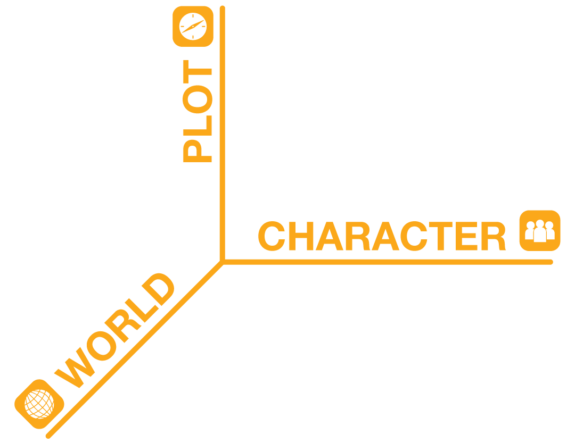If you’ve ever taken a writing class, you’ve probably heard the adage “show, don’t tell.” But what does that even mean?
What “show, don’t tell” really boils down to is a question of scene versus exposition. “Show” puts readers right in the middle of the action so they can see the scene unfold almost as if in real time. “Tell,” on the other hand, allows the writer to gloss over unimportant details via exposition, thus being able to jump to more important parts of the story.
Show vs. Tell
Personally, I have a bone to pick with that advice, “show, don’t tell.” It implies that showing is more important than telling, when the truth is that both scene and exposition are powerful craft tools, each with distinct advantages and uses. We can do things in a scene that we can’t do in exposition, just as exposition allows us to accomplish things that we can’t do in a scene.
A scene allows us to experience a moment in the story as if it is happening right in front of us. We see characters interact and we might even get a window into some of their thoughts. We experience the setting all around us and we see the events of the story unfold almost as though we are there with the characters.
This is all well and good, but imagine you had to do this for every last, insignificant moment of your story. Imagine you had to show your character wiping the sleep crud from their eyes and brushing their teeth in the morning. Imagine you had to describe every crack in the sidewalk that they passed on their walk to work. Imagine you were forced to show everything, from the character soaping their hair in the shower, to them tossing out takeout containers and cleaning up after dinner.
That would get boring very quickly.
You see, there’s a benefit to being able to skip time or jump from one location to another. Sometimes all you want to do is gloss over the unimportant stuff so you can get to the juicy moments in the next full scene. This is where exposition can be useful.
Exposition is the unsung hero of storytelling. Without it, we would have to show everything and it would take thousands of pages just to get our characters through a single day. With exposition we can say things like “later that day” or “he went to work” and give readers important information in a compressed amount of space.
The main danger of exposition is that writers sometimes overuse it. They rely too heavily on spelling things out rather than showing a scene and allowing the reader to interpret it as they will. Scenes bring readers into the story, almost like they are active participants observing the characters and drawing inferences for themselves. As writers, of course we want readers to become immersed in our stories. We want them to feel as though they are right there with the characters. This is why we need to be strategic with what we show in scenes, versus what we summarize through exposition. Writing is a delicate balance between the two.
One of the keys to striking this balance is understanding what a scene is… and what it isn’t. In order to do so, we need to examine the fundamental components of story itself.
Three Essential Elements of Story
I believe stories exist in a three-dimensional space, where each dimension is a fundamental element of storytelling. These three elements are character, plot, and world. Imagine we could plot stories on a three-axis diagram, not unlike the ones we used to draw in high school geometry class. The X axis represents character, the Y axis represents plot, and the Z axis represents world. We can then map where a given story “lives” in that three-dimensional space based on how much (or how little) of each element is present.

Let’s consider some examples. Adventure stories, like the Indiana Jones films, have a lot happening in terms of plot and also have vivid, sprawling settings. Thus these stories would be high on plot and world, but somewhat lower in terms of character. Literary fiction, on the other hand, is usually very high in character and also often has intricate descriptions of the world, but the plot component is less prominent. Finally, if you have a lot of character and plot, but practically no world… well, that would be Dante’s Paradiso (and we all know that’s the least popular installment of his Divine comedy).
This is all well and good, but what does it have to do with scenes?
A Definition of Scene
I believe that a scene is the smallest component of a story that still retains all of that story’s properties. This is not unlike how a cell has all the same DNA as the rest of the organism, thus making it the smallest building block of that living thing. So too is a scene the smallest comprehensive component of a story. This means that, like stories, scenes must also have those three essential elements: character, plot, and world. If one of those elements is missing, we don’t have a true scene.
I like to think of scenes as satisfying the five W’s: who, what, when, where, and why. The “who” is the character or characters in the given scene. The “what” is what happens in the course of that scene. The “when” and “where” represent the setting or location where that part of the story happens. The “who,” “what” and “when/where” represent the character, plot, and world dimensions respectively. If one of those elements is missing, that passage in the story is no longer an actual scene.
Finally, we have the “why.” This is the one component that belongs to the writer alone. It is the purpose of the scene, why the scene exists in the story. Readers will never experience this “why” because it never actually appears in the scene itself. Yet, the writer needs to know it in order to justify that scene’s existence in the narrative. If we cannot express why a particular scene exists in the story, then we must consider whether it should be in that story at all.
Show AND Tell
Writing great scenes is an important part of the storytelling process and something that all writers need to learn. Because scenes are the fundamental building blocks of a story, we need to make sure our scenes are strong, otherwise our narrative will fall flat. That said, we also need to appreciate the role of exposition in our storytelling. Yes, scenes are important, but if we show everything we will bore our readers to tears. Sometimes we have to tell, not show.
The key is to be strategic about what we show and what we tell, finding a balance between the two. We need to understand the benefits and drawbacks of scenes and exposition in order to use both techniques to their best effect. Ultimately, our goal is to create a great story that draws our readers in and keeps them turning pages. To do this, we need to show and tell.
Until next time, keep writing and keep being awesome!

P.S. For more info on Gabriela Pereira, the founder and instigator of DIY MFA, check out her profile page.









